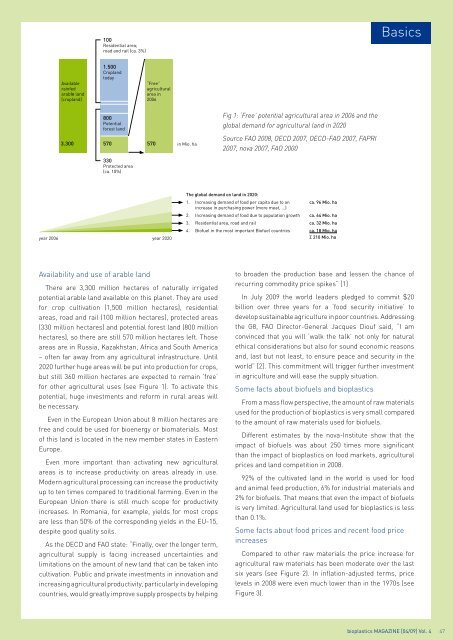bioplasticsMAGAZINE_0904
bioplasticsMAGAZINE_0904
bioplasticsMAGAZINE_0904
You also want an ePaper? Increase the reach of your titles
YUMPU automatically turns print PDFs into web optimized ePapers that Google loves.
100<br />
Residential area;<br />
road and rail (ca. 3%)<br />
Basics<br />
Available<br />
rainfed<br />
arable land<br />
(cropland)<br />
1.500<br />
Cropland<br />
today<br />
“Free”<br />
agricultural<br />
area in<br />
2006<br />
800<br />
Potential<br />
forest land<br />
Fig 1: ‘Free’ potential agricultural area in 2006 and the<br />
global demand for agricultural land in 2020<br />
3.300<br />
570<br />
570 in Mio. ha<br />
Source FAO 2008, OECD 2007, OECD-FAO 2007, FAPRI<br />
2007, nova 2007, FAO 2000<br />
330<br />
Protected area<br />
(ca. 10%)<br />
year 2006 year 2020<br />
The global demand on land in 2020:<br />
1. Increasing demand of food per capita due to an ca. 96 Mio. ha<br />
increase in purchasing power (more meat, ...)<br />
2. Increasing demand of food due to population growth ca. 64 Mio. ha<br />
3. Residential area, road and rail ca. 32 Mio. ha<br />
4. Biofuel in the most important Biofuel countries ca. 18 Mio. ha<br />
∑ 210 Mio. ha<br />
Availability and use of arable land<br />
There are 3,300 million hectares of naturally irrigated<br />
potential arable land available on this planet. They are used<br />
for crop cultivation (1,500 million hectares), residential<br />
areas, road and rail (100 million hectares), protected areas<br />
(330 million hectares) and potential forest land (800 million<br />
hectares), so there are still 570 million hectares left. Those<br />
areas are in Russia, Kazakhstan, Africa and South America<br />
– often far away from any agricultural infrastructure. Until<br />
2020 further huge areas will be put into production for crops,<br />
but still 360 million hectares are expected to remain ‘free‘<br />
for other agricultural uses (see Figure 1). To activate this<br />
potential, huge investments and reform in rural areas will<br />
be necessary.<br />
Even in the European Union about 8 million hectares are<br />
free and could be used for bioenergy or biomaterials. Most<br />
of this land is located in the new member states in Eastern<br />
Europe.<br />
Even more important than activating new agricultural<br />
areas is to increase productivity on areas already in use.<br />
Modern agricultural processing can increase the productivity<br />
up to ten times compared to traditional farming. Even in the<br />
European Union there is still much scope for productivity<br />
increases. In Romania, for example, yields for most crops<br />
are less than 50% of the corresponding yields in the EU-15,<br />
despite good quality soils.<br />
As the OECD and FAO state: “Finally, over the longer term,<br />
agricultural supply is facing increased uncertainties and<br />
limitations on the amount of new land that can be taken into<br />
cultivation. Public and private investments in innovation and<br />
increasing agricultural productivity, particularly in developing<br />
countries, would greatly improve supply prospects by helping<br />
to broaden the production base and lessen the chance of<br />
recurring commodity price spikes” [1]<br />
In July 2009 the world leaders pledged to commit $20<br />
billion over three years for a ‘food security initiative‘ to<br />
develop sustainable agriculture in poor countries. Addressing<br />
the G8, FAO Director-General Jacques Diouf said, “I am<br />
convinced that you will ‘walk the talk’ not only for natural<br />
ethical considerations but also for sound economic reasons<br />
and, last but not least, to ensure peace and security in the<br />
world” [2]. This commitment will trigger further investment<br />
in agriculture and will ease the supply situation.<br />
Some facts about biofuels and bioplastics<br />
From a mass flow perspective, the amount of raw materials<br />
used for the production of bioplastics is very small compared<br />
to the amount of raw materials used for biofuels.<br />
Different estimates by the nova-Institute show that the<br />
impact of biofuels was about 250 times more significant<br />
than the impact of bioplastics on food markets, agricultural<br />
prices and land competition in 2008.<br />
92% of the cultivated land in the world is used for food<br />
and animal feed production, 6% for industrial materials and<br />
2% for biofuels. That means that even the impact of biofuels<br />
is very limited. Agricultural land used for bioplastics is less<br />
than 0.1%.<br />
Some facts about food prices and recent food price<br />
increases<br />
Compared to other raw materials the price increase for<br />
agricultural raw materials has been moderate over the last<br />
six years (see Figure 2). In inflation-adjusted terms, price<br />
levels in 2008 were even much lower than in the 1970s (see<br />
Figure 3).<br />
bioplastics MAGAZINE [04/09] Vol. 4 47


















